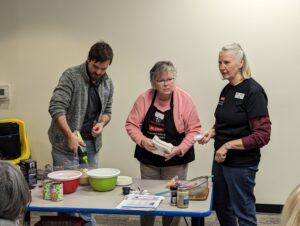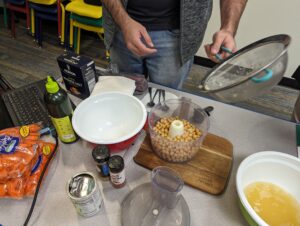Chickpeas or Garbanzo Beans…
go.ncsu.edu/readext?993794
en Español / em Português
El inglés es el idioma de control de esta página. En la medida en que haya algún conflicto entre la traducción al inglés y la traducción, el inglés prevalece.
Al hacer clic en el enlace de traducción se activa un servicio de traducción gratuito para convertir la página al español. Al igual que con cualquier traducción por Internet, la conversión no es sensible al contexto y puede que no traduzca el texto en su significado original. NC State Extension no garantiza la exactitud del texto traducido. Por favor, tenga en cuenta que algunas aplicaciones y/o servicios pueden no funcionar como se espera cuando se traducen.
Português
Inglês é o idioma de controle desta página. Na medida que haja algum conflito entre o texto original em Inglês e a tradução, o Inglês prevalece.
Ao clicar no link de tradução, um serviço gratuito de tradução será ativado para converter a página para o Português. Como em qualquer tradução pela internet, a conversão não é sensivel ao contexto e pode não ocorrer a tradução para o significado orginal. O serviço de Extensão da Carolina do Norte (NC State Extension) não garante a exatidão do texto traduzido. Por favor, observe que algumas funções ou serviços podem não funcionar como esperado após a tradução.
English
English is the controlling language of this page. To the extent there is any conflict between the English text and the translation, English controls.
Clicking on the translation link activates a free translation service to convert the page to Spanish. As with any Internet translation, the conversion is not context-sensitive and may not translate the text to its original meaning. NC State Extension does not guarantee the accuracy of the translated text. Please note that some applications and/or services may not function as expected when translated.
Collapse ▲Chickpeas or garbanzo beans. Just different names for the same food. But no matter what you call them these beans can provide you with a flavorful source of protein that can enhance a variety of recipes.
Using garbanzo beans (or any bean for that matter) as your protein source is one of the most impactful ways you can improve your diet. In the Mediterranean Diet, the
recommendation is to replace some of the meat in your diet with beans, nuts and seeds more often.
A half cup of cooked chickpeas – without salt – contains around 130 calories, 22g
carbohydrates, 6g fiber, 7g protein, and 2g of fat. They also contain vitamins and
minerals, including folate, potassium, and iron.
If you’ve never purchased garbanzo beans, they can be found in several different
locations in the grocery store. Select the kind you buy based on your purpose, how
much time you have and your budget.
You can find them in bags or bulk bins with other dried peas, beans and lentils. If you’re not familiar with this section of the grocery store it’s worth the investigation because any of these products can be a good source of protein. These are usually the lowest in price of any of the bean/protein sources.
You can also get canned chickpeas. These are a great convenience item, because you can just open, rinse, and eat. Your best bet is to look for reduced-sodium or no-salt- added varieties. If you can’t find these, rinsing the canned beans before using them will reduce the amount of salt by about 30%.
Chickpeas can also be found in other areas of the store. You might also see chickpea- based pastas (usually gluten-free). There are also chips, roasted and puffed snacks made with chickpeas.
Starting with dried beans is the most time consuming (and least expensive) way to use garbanzo beans. Soak the dried beans overnight covered in water. Drain and add fresh water to cover and cook slowly until very tender. It usually takes 30-60 minutes. Dried beans can also be cooked in a slow cooker or in a pressure cooker. How long you cook and how tender you let them become depends upon their final use.
Hummus, a bean dip, might be the best-known use of chickpeas. In a recent “Med
Instead of Meds” class our Family and Consumer Science Agent, Avery Ashley
 and our Extension Master Food Volunteers demonstrated an easy and quick recipe for hummus. This recipe uses canned chickpeas, but if you have some you’ve soaked and cooked yourself, they will work well too.
and our Extension Master Food Volunteers demonstrated an easy and quick recipe for hummus. This recipe uses canned chickpeas, but if you have some you’ve soaked and cooked yourself, they will work well too.
Homemade Hummus
- 1 (15 ounce) can chickpeas, drain (keep the liquid)

- ¼ cup lemon juice (or juice from 1 large lemon)
- ¼ cup well-stirred tahini (ground sesame seeds)
- 1 small garlic clove, minced
- 2 Tablespoons olive oil
- ½ teaspoon ground cumin
- Salt to taste
- 2-3 Tablespoons water or aquafaba
- Dash of ground paprika (optional)
In bowl of a food processor or blender combine the drained chickpeas, lemon juice,
tahini, garlic, olive oil, cumin and salt. Process 30 seconds, scrape sides and bottom of the bowl and process another 60 seconds or until well blended and smooth. If it is too thick or there are still bits of chickpeas, add 2-3 tablespoons of water or the liquid from the beans and continue processing. It should be creamy. Taste for salt. Serve drizzled with olive oil or a dash of paprika. Good with whole wheat pita bread, whole wheat pretzels, carrots and celery sticks. Can be stored in the refrigerator for up to seven days.
There is a bonus hidden in that can or pot of chickpeas. It’s the liquid that’s drained off. Don’t throw it away! It’s called aquafaba. The word comes for Latin for water (aqua) and bean (faba). The starch and protein in aquafaba make it a binding agent, thickener and emulsifier. It can be whipped with cream of tarter to make dairy-free whipped topping. It’s also used as a substitute for eggs (3 tablespoons aquafaba = 1 whole egg). You’re going to have to experiment with this aquafaba a little because the protein and starch in it can vary greatly with each batch.
Here are a few more recipe items for using chickpeas from our Med Instead of Meds curriculum:
- Honey Roasted Chickpeas
- Chickpea and Black Bean Salad
- Whole wheat Pasta Beans and Greens



